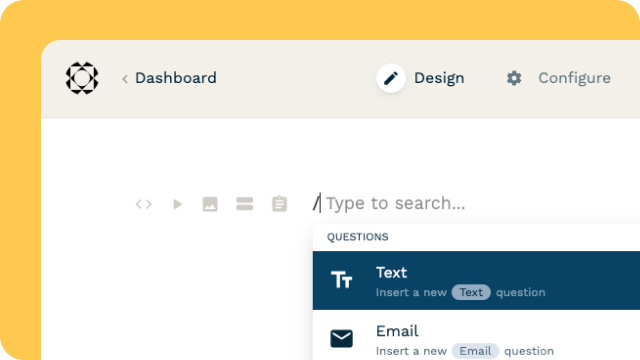
All Solutions

Explore all the solutions you can create with Paperform: surveys, quizzes, tests, payment forms, scheduling forms, and a whole lot more.
See all solutions











Connect with over 2,000 popular apps and software to improve productivity and automate workflows
See all integrationsProducts
Solutions
All Solutions

Explore all the solutions you can create with Paperform: surveys, quizzes, tests, payment forms, scheduling forms, and a whole lot more.
See all solutionsIntegrations

Connect with over 2,000 popular apps and software to improve productivity and automate workflows
See all integrationsResources
7 ways to boost form conversion rates

Sure, you want people to visit your website. But that’s not the end of the journey—in fact, it’s usually only the beginning.
Once you’ve hooked people, you want them to take the next step and do something while they’re there. Make a purchase. Sign up for your newsletter. Download a resource. Book a demo. Leave a review. Contact you.
Whatever your specific next step is, most of those interactions have one big thing in common: a form. Visitors need to complete an online form in order to move forward with what they (and you) want.
It all sounds simple enough when you spell it out like that. But here’s the hard truth: It can be downright tough to get somebody to go all the way from A to Z and submit an online form, with an alarming 81% of users admitting that they’ve abandoned an online form after starting to fill it out.
Understandably, you want more people to make it across the finish line—to actually make it through every form field and submit that information to you. To use the industry lingo, what you really want is to improve your form conversion rates.
What exactly is a form conversion rate?
Your form conversion rate is the percentage of people who complete and submit your online form. Put simply, your conversion rate indicates what percentage of the people who accessed your form actually converted to real submissions.
How do you calculate your own form conversion rate?
You don’t need to be a math whiz to figure out the conversion rate for your own forms. The formula is straightforward and simple. Access your website analytics and form analytics to identify:
- Total number of visitors to your form page
- Total number of form submissions
Divide your total number of submissions (those are your conversions) by the total number of visitors. Multiply by 100 to make it a percentage. That’s your conversion rate. So, if you had 1,200 people visit your form landing page and 48 submissions, your conversion rate is 4%.
What’s considered a “good” conversion rate for forms?
Much like anything else, what’s considered “good” will vary across different industries, brands, and offers.
Some estimates state that the median conversion rate is in the range of 3-5.5%. Others go a touch lower, stating that the average conversion rate across industries is 2.9%.
If your eyes are popping out of your head at those low percentages, remember what we said at the beginning: It’s downright challenging to get somebody—let alone everybody—to complete your online form. So, aiming for a conversion rate above 3% is a reasonable goal that will still put you ahead of the curve.
What impacts your form conversion rate?
You probably know by now that you don’t have a ton of control over your customers’ behavior (it’d be nice, wouldn’t it?). But with that said, there are some different levers you can pull to nudge them in the right direction, and the first is to consider the factors that influence your form conversion rate.
There’s a lot at play here. Aspects like your existing relationship with the customer or visitor, how desirable your offer is, and your overall brand identity all play a role in how willing people are to complete and submit your online forms.
When you think about your form itself, conversion rates are heavily impacted by:
- Form design: Forms serve a specific purpose—they aren’t a place for you to flex your design chops. Clean and simple forms almost always perform better than those that are visually cluttered and chaotic.
- Form length: If people peek at your form and see endless fields to fill out, they’re more likely to jump ship. In general, the shorter you can keep your form, the better.
- User experience: Even if visitors get something in return for completing your form, they still need to invest time and energy to get there. Making the process as painless as possible for them—no glitches, clunky questions, or unnecessary fields—increases the likelihood that they’ll make it to the end. Plus, it shows some extra care and consideration for your customer, which helps foster more trust and loyalty.
7 tips to improve your form conversion rates
No matter what type of form you’re creating, your goal is pretty simple: You want people to fill it out. After all, you wouldn’t create it if you didn’t want submissions.
Understanding the various aspects that impact your conversion rates is a solid starting point. But if you’re looking to really level-up your form conversions, here are seven other strategies to try.
1. Keep it short and sweet
Some forms will naturally require more fields and context than others. A customer survey, for example, will understandably be longer than a subscribe form to sign up for your email list. It’s up to you to determine how much length your form actually warrants.
However, as you do so, avoid the common trap of thinking, “We should gather as much information as we can from this person while we have them!”
It’s an easy assumption to make—that you should capitalize on this opportunity to collect everything you can get your hands on right now, rather than asking that person to complete another separate form later. But too long of form will quickly turn off your visitor and send them running for the hills.
In combing through our own data here at Paperform, we’ve found that, in general, the shorter your form, the better your conversion rates. Another small experiment shows that removing just one form field can boost form conversion rates by as much as 26%.
So, as you create your form, stay narrowly focused on this question: What information do you actually need from the customer right now?
In the case of the customer survey, you likely want their name, email address, and answers to the prompts or questions. But you probably don’t need a mailing address or a phone number.
2. Use intuitive instructions
Your form shouldn’t feel like a puzzle or a code to crack—people should easily understand what information you need and where they should put it with just a quick glance at your form.
That all hinges on form psychology and intuitive design. That sounds complicated, but there are seemingly small details that make a big difference, such as:
- Your questions or field labels should be left-aligned on your form
- Your questions or field labels should go on top of the form field, not underneath
You can also guide people through your form by using “help text” with your form questions. This can provide additional details about the formatting of their answers (such as how to list their phone number) or even some relevant information and context about your business.
 (Source: Paperform)
(Source: Paperform)Paperform makes it easy to customize your help text. Get started with Paperform for free today.
3. Consider your form placement
Perhaps you’ve noticed that your form conversion rate is lower than you’d like it to be. Before you start digging into the details of your actual form, it’s worth asking yourself: Where is it?
If people need to pass through seemingly endless links, checkboxes, and redirects to finally get to your form landing page, it shouldn’t be a surprise that it’s not converting well. If you want more conversions, then your form needs to be prominent and readily accessible.
In an ideal world, your form will be placed above the fold—meaning people can see it without any scrolling. Research shows that, regardless of the type of device they’re on, your visitors will fill out your forms more frequently when they’re placed above the fold. In fact, the average difference in how users treat content that’s above the fold versus below the fold is a whopping 85%.
So, if you want to increase your conversion rates, you can try something as simple as switching up (literally, move it up) where your form is located on your site.
4. Level up your calls to action
While you might not always think of it that way, your form is a call to action. You’re asking your visitors to do something specific: complete your form.
As you build your online form, it’s easy to slap a big “submit” button at the end and call it a day. But tailoring and experimenting with your CTA button can help inspire people to actually follow through. There’s no shortage of best practices when it comes to CTAs:
- Use a bright color for your form “submit” button (red is particularly popular)
- Rather than sticking with general “submit” language, try out words and phrases that are more specific to your form like “sign up,” “subscribe,” or “talk to us”
- Use words like “now” or “today” with your CTA language to instill a sense of urgency
While a simple button that says “submit” certainly gets the job done, some of the above tweaks can make your call to action more powerful.
5. Clearly communicate success and failure
You’ve probably had this happen before: You went through an entire form and clicked the button only for…uhh…wait a minute. Did anything happen? You’re stuck on the same page and left wondering if your responses actually went through or if you should click the button again (okay, another 84 times).
That’s frustrating for users. And even if their form was submitted successfully this time, you can bet it’ll make them hesitant to fill out another one of your forms in the future.
When people complete a form, they should get a clear indication of whether or not it was submitted. With Paperform, you can easily customize what sort of confirmation people receive—like an email or a success page.
 (Source: Paperform)
(Source: Paperform)If the form wasn’t submitted or needs corrections, users need to know that too. This means giving them more than a generic validation error.
Any fields with errors should be clearly marked, and people should also receive clear instructions about what needs to be fixed in order for the form to submit correctly—whether they made a formatting error, skipped a required question, or used an email address that’s already registered.
 (Source: Paperform)
(Source: Paperform)6. Prioritize the user experience
An online form seems like a simple enough request, but it’s important to remember that it demands time, attention, and energy from your customers or users. Hold up your end of the bargain by making it as streamlined as possible for them. Here are a few things to pay attention to:
- Use integrations and pre-filling to fill in answers you already know about the user. It saves them time and also personalizes the process.
- Use conditional logic to tailor the journey as the user works through the form. Conditional logic changes how your form behaves based on specific actions and answers. For example, if a user answers “no” when asked if they’re familiar with your brand, the form will automatically remove questions about how they heard about you.
- Use a progress bar to help people understand how much further they have to go in your form—and what their estimated time commitment is.
It’s smart to regularly test out your own forms (set a reminder in your calendar every few months or so!) and make sure nothing is broken, glitchy, irrelevant, or frustrating. There’s no better way to improve the user experience than to actually assume the role of the user.
Paperform offers all of the above features (and more). Get started with Paperform for free today.
7. Squelch security fears
There are plenty of reasons why people might abandon your form, even after they’ve made some progress. But one of the biggest reasons could surprise you: security.
Security concerns were actually the top reason people abandoned forms in a 2018 study, ranking above other factors like form length, advertisements, and unnecessary questions. It’s proof that people care about what happens with the information they submit to you.
Look for an online form creator that follows industry standards with regards to security and compliance. For any forms that request Personally Identifiable Information (PII), include a link to your privacy policy directly with your form to comply with various data protection and privacy laws.
Get more forms across the finish line
On the surface, an online form feels like a small, non-disruptive, and fairly inconsequential request. Heck, it’s easy and will only take people a minute or two to fill out.
But despite the seemingly low effort, it’s still surprisingly hard to get people to actually complete and submit an online form—a statement supported by the shockingly low form conversion rates seen across industries.
It’s time to stop treating your online forms as an afterthought and to start seeing them for what they are: an integral part of your brand and your overall customer experience. And the best way to give your forms the attention they deserve is to commit to experimentation like you would with any other marketing strategy.
Try different things with your form placement, headlines, design, language, and more to see which ones have the most meaningful impact on your conversions. Doing so will help you get more of the forms that matter to you most: completed ones.
Boosting your form conversion rates starts with having the right form creator. Get started with Paperform for free today.
Form a better life now.
Get your 7 day unrestricted trialHere is the ultimate list of online form builders, what they do best, their pricing, and examples to...
Discover how embedded smart forms can boost conversions, improve user experience, and turn your webs...
The ultimate list of Black Friday and Cyber Monday SaaS deals for 2025
Looking for a worthy alternative to Zapier? In this guide, we've reviewed the best automation platfo...